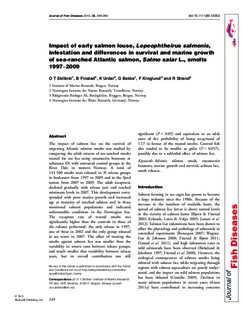| dc.contributor.author | Skilbrei, Ove | |
| dc.contributor.author | Finstad, Bengt | |
| dc.contributor.author | Urdal, K. | |
| dc.contributor.author | Bakke, Gunnar | |
| dc.contributor.author | Kroglund, F. | |
| dc.contributor.author | Strand, R. | |
| dc.date.accessioned | 2013-07-30T08:46:16Z | |
| dc.date.available | 2013-07-30T08:46:16Z | |
| dc.date.issued | 2013-01-13 | |
| dc.identifier.citation | Skilbrei, O. T., Finstad, B., Urdal, K., Bakke, G., Kroglund, F. and Strand, R. (2013), Impact of early salmon louse, Lepeophtheirus salmonis, infestation and differences in survival and marine growth of sea-ranched Atlantic salmon, Salmo salar L., smolts 1997–2009. Journal of Fish Diseases, 36: 249–260. | no_NO |
| dc.identifier.issn | 1365-2761 | |
| dc.identifier.uri | http://hdl.handle.net/11250/109059 | |
| dc.description.abstract | The impact of salmon lice on the survival of migrating Atlantic salmon smolts was studied by comparing the adult returns of sea-ranched smolts treated for sea lice using emamectin benzoate or substance EX with untreated control groups in the River Dale in western Norway. A total of 143500 smolts were released in 35 release groups in freshwater from 1997 to 2009 and in the fjord system from 2007 to 2009. The adult recaptures declined gradually with release year and reached minimum levels in 2007. This development corresponded with poor marine growth and increased age at maturity of ranched salmon and in three monitored salmon populations and indicated unfavourable conditions in the Norwegian Sea. The recapture rate of treated smolts was significantly higher than the controls in three of the releases performed: the only release in 1997, one of three in 2002 and the only group released in sea water in 2007. The effect of treating the smolts against salmon lice was smaller than the variability in return rates between release groups, and much smaller that variability between release years, but its overall contribution was still significant (P<0.05) and equivalent to an odds ratio of the probability of being recaptured of 1.17 in favour of the treated smolts. Control fish also tended to be smaller as grilse (P=0.057), possibly due to a sublethal effect of salmon lice. | no_NO |
| dc.language.iso | eng | no_NO |
| dc.publisher | Wiley | no_NO |
| dc.title | Impact of early salmon louse, Lepeophtheirus salmonis, infestation and differences in survival and marine growth of sea-ranched Atlantic salmon, Salmo salar L., smolts 1997-2009 | no_NO |
| dc.type | Journal article | no_NO |
| dc.type | Peer reviewed | no_NO |
| dc.subject.nsi | VDP::Agriculture and fishery disciplines: 900::Fisheries science: 920::Fish health: 923 | no_NO |
| dc.source.pagenumber | 249-260 | no_NO |
| dc.source.volume | 36 | no_NO |
| dc.source.journal | Journal of Fish Diseases | no_NO |
| dc.source.issue | 3 | no_NO |
| dc.identifier.doi | 10.1111/jfd.12052 | |
